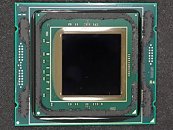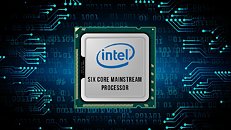Friday, September 22nd 2017

Intel Core i7 8700K Reportedly Reaches 4.8 GHz Easily, 5 GHz+ Requires Delid
A report out of Expreview says that users should expect Intel's 8700K 6-core processor to easily clock up to 4.8 GHz with conventional cooling methods. Apparently, the chip doesn't even need that much voltage to achieve this feat either; however, thermal constraints are quickly hit when pushing Intel's latest (upcoming) leader for the mainstream desktop parts. Expreview says that due to the much increased temperatures, users who want to eke out the most performance from their CPU purchase will likely have to try and resort to delidding of their 8700K. While that likely wouldn't have been necessary with Intel's 7700K processors, remember that here we have two extra CPU cores drawing power and producing waste heat, so it makes sense that thermals will be a bigger problem.
This is understandable: Intel is still using their much chagrined (and divisive) TIM as a heat conductor between the CPU die and the CPU's IHS (Integrated Heat Spreader), which has been proven to be a less than adequate way of conducting said heat. However, we all knew this would be the case; remember that Intel's HEDT HCC processors also feature this TIM, and in that case, we're talking of up to 18-core processors that can cost up to $1,999 - if Intel couldn't be bothered to spend the extra cents for actual solder as an interface material there, they certainly wouldn't do so here. As with almost all peeks at as of yet unreleased products, take this report (particularly when it comes to frequencies, as each CPU overclocks differently) with a grain of salt, please.
Source:
Expreview
This is understandable: Intel is still using their much chagrined (and divisive) TIM as a heat conductor between the CPU die and the CPU's IHS (Integrated Heat Spreader), which has been proven to be a less than adequate way of conducting said heat. However, we all knew this would be the case; remember that Intel's HEDT HCC processors also feature this TIM, and in that case, we're talking of up to 18-core processors that can cost up to $1,999 - if Intel couldn't be bothered to spend the extra cents for actual solder as an interface material there, they certainly wouldn't do so here. As with almost all peeks at as of yet unreleased products, take this report (particularly when it comes to frequencies, as each CPU overclocks differently) with a grain of salt, please.


119 Comments on Intel Core i7 8700K Reportedly Reaches 4.8 GHz Easily, 5 GHz+ Requires Delid
You get an "A" for effort, but your whole argument is flawed.
Yes, I know, wccftech, but it does look like we have seen these reports before. I wonder how much better really are the new 14nm++ and Coffee Lake, compared to the original 14nm and Skylake.
Oh look, what's this CPU I just got? Oh wait, it's not a CPU, it's two! And an M.2 device? WTF... So... I don't need to speculate. :P
I mean, even if there is a fracture in there, the CPU heatsink pressure would probably keep it together, making difference unmeasurable. Especially on monolithic designs with Intel. I find it unlikely that a micro crack would affect just 1 core somehow. For that to happen it would have to be a huge crack which just doesn't seem to make sense.
You do also need to keep in mind that these guys are likely using some weird blend of metals that is highly un-tested except in-house. There's probably some dude whose job it is requires him or her to play with this stuff day in and day out, until he retires. I'd love to talk to this guy.
Oh well
If TIM is crap and solder is bound to crack, liquid metal is best of both worlds. It can't crack and it has superior heat transmission. Cheaper CPU's can use TIM as it doesn't really matter for their heat output, but with 6+ core monsters, I want best of the best.
I dont get this....sure it can be better, but it does just fine at st9ck and overclocked...which probably 1% of people do.
The only trend we are really seeing is that Intel is eating up our OC headroom for us because the Core arch is nearing its end of life and a competitor presents a good product that can match its performance. At the same time, it cannot match its clocks by a long shot, while being soldered.
To me that is 'nuff said' with regards to solder vs TIM. What remains is a discussion for the 1% that likes to seek out limits and I am not surprised they find them...
Lol @EarthDog ... Great minds think alike or... I had not even read your response yet :D
Few people, even here give a hoot about that last 100 mhz.
Dont split hairs and act stupid. Clearly we are talking swapping out the tim and placing the IHS back on...
BTW, that's what it is, paste vs solder, since both are a TIM. :fear:
Move on as i have and many millions...
You can hate, yell, wish death to Intel but they are geniusess and you... know that, don't try to find the reason behind, you'll never find it, but be sure of this, IT WORKS!
Here you have thread with hundrets of examples for delided Intel CPUs (Ivybridge and onwards). including pictures. On some of these pictures you can clearly see that paste was drying out after only 1-2 year use ... you can imagine how this paste hinders OC.